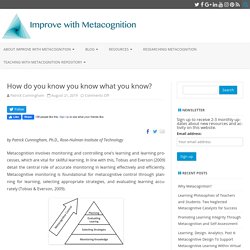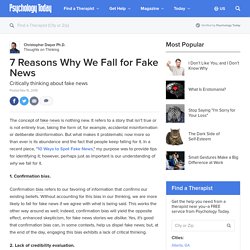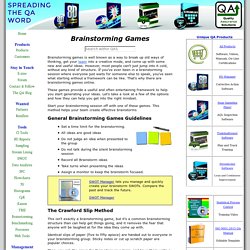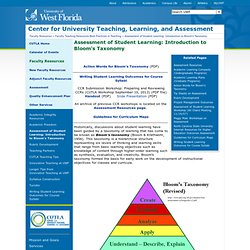

How do you know you know what you know? - Improve with Metacognition. By Patrick Cunningham, Ph.D., Rose-Hulman Institute of Technology Metacognition involves monitoring and controlling one’s learning and learning processes, which are vital for skillful learning.

In line with this, Tobias and Everson (2009) detail the central role of accurate monitoring in learning effectively and efficiently. Metacognitive monitoring is foundational for metacognitive control through planning for learning, selecting appropriate strategies, and evaluating learning accurately (Tobias & Everson, 2009). Getting started with Metacognition. A metacognitive approach typically involves students applying metacognitive strategies to respond to clear and explicit learning goals which have either been set by the teacher or identified by the student themselves. The student uses their metacognitive strategies to plan, monitor and evaluate their own progress towards achieving the learning goals. In order to apply a metacognitive approach, learners need access to: 1.
A set of strategies to use. 2. A classroom environment that encourages the learners to use, explore and develop their metacognitive skills. 1. Metacognition. 7 Reasons Why We Fall for Fake News. The concept of fake news is nothing new.

It refers to a story that isn’t true or is not entirely true, taking the form of, for example, accidental misinformation or deliberate disinformation. But what makes it problematic now more so than ever is its abundance and the fact that people keep falling for it. In a recent piece, "10 Ways to Spot Fake News," my purpose was to provide tips for identifying it; however, perhaps just as important is our understanding of why we fall for it. article continues after advertisement 1. Brainstorming Games Help You Generate Problem Solving Ideas.
Brainstorming games is well known as a way to break up old ways of thinking, get your team into a creative mode, and come up with some new and useful ideas.

However, most people can't just jump into it cold, without any kind of structure. If you've ever been in a brainstorming session where everyone just waits for someone else to speak, you've seen what starting without a framework can be like. That's why there are brainstorming games online. These games provide a useful and often entertaining framework to help you start generating your ideas. Let's take a look at a few of the options and how they can help you get into the right mindset.
Start your brainstorming session off with one of these games. General Brainstorming Games Guidelines SWOT Manager lets you manage and quickly create your brainstorm SWOTs. SWOT Manager The Crawford Slip Method. Promotethink. Critical thinking workbook. 14 Bloom's Taxonomy Posters For Teachers. 14 Brilliant Bloom’s Taxonomy Posters For Teachers by TeachThought Staff Bloom’s Taxonomy is a useful tool for assessment design, but using it only for that function is like using a race car to go to the grocery–a huge waste of potential.

In an upcoming post we’re going to look at better use of Bloom’s taxonomy in the classroom, but during research for that post it became interesting how many variations there are of the original work. While a handful of the charts below only show aesthetic changes compared to others, most are concept maps of sorts–with graphic design that signifies extended function (power verbs), detail (clear explanations), or features of some sort (Bloom’s Taxonomy tasks by level).
See also 10 Team-Building Games That Promote Critical Thinking The follow simple, student-centered Bloom’s graphics were created by helloliteracy! The following “Bloom’s pinwheel” comes from Kelly Tenkley and ilearntechnology.com: 3 Digital Reading Challenges for Summer. This summer, more than ever, how we read may be just as important as what we read.

In April, researchers at West Chester University published a report arguing that eReaders could lead to decreased comprehension and fluency. In this New York Times article, the professors suggest that the interactivity, easy access to a dictionary, and constant use of text-to-speech could actually hinder the development of students' reading skills. However, the examples highlighted in the article focus on the content -- comparing traditional, paper-based books to electronic versions with a high level of interactivity such as games and video -- rather than addressing the skills and strategies implemented in the reading process. As I wrote in a previous post, students now have the potential to customize their reading experiences with mobile devices. So this summer, instead of reading in whatever manner you would traditionally use, I'd like to suggest three digital reading challenges. Diigo Features:
Being a Better Online Reader. Soon after Maryanne Wolf published “Proust and the Squid,” a history of the science and the development of the reading brain from antiquity to the twenty-first century, she began to receive letters from readers.

Hundreds of them. While the backgrounds of the writers varied, a theme began to emerge: the more reading moved online, the less students seemed to understand. There were the architects who wrote to her about students who relied so heavily on ready digital information that they were unprepared to address basic problems onsite. There were the neurosurgeons who worried about the “cut-and-paste chart mentality” that their students exhibited, missing crucial details because they failed to delve deeply enough into any one case. And there were, of course, the English teachers who lamented that no one wanted to read Henry James anymore.
Certainly, as we turn to online reading, the physiology of the reading process itself shifts; we don’t read the same way online as we do on paper. Center for University Teaching, Learning, and Assessment - Assessment of Student Learning: Introduction to Bloom's Taxonomy. Action Words for Bloom's Taxonomy (PDF) Historically, discussions about student learning have been guided by a taxonomy of learning that has come to be known as Bloom’s taxonomy (Bloom & Krathwohl, 1956).

This taxonomy is a hierarchical structure representing six levels of thinking and learning skills that range from basic learning objectives such as knowledge of content through higher-order learning such as synthesis, evaluation, and creativity. Bloom’s taxonomy formed the basis for early work on the development of instructional objectives for classes and curricula. More recently, emphasis has shifted from instructional objectives, which describe what instructors do and the content of material presented during classroom instruction, to student learning outcomes, which describe what students can do as a result of their educational experiences. This change in emphasis is associated with changes in the language used and changes in expectations about instructional style. References. Bloom's Digital Taxonomy. Teacher to Teacher.